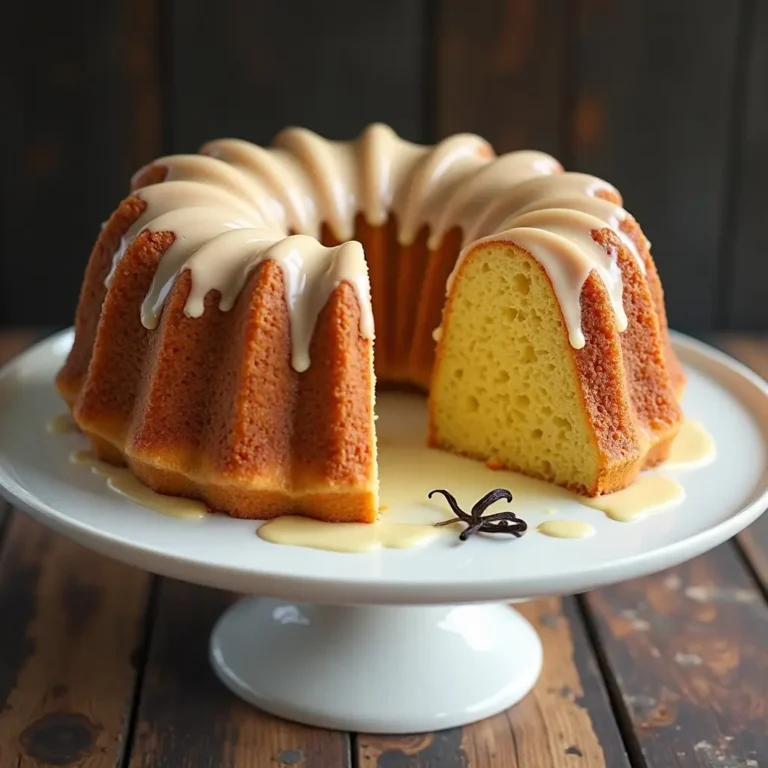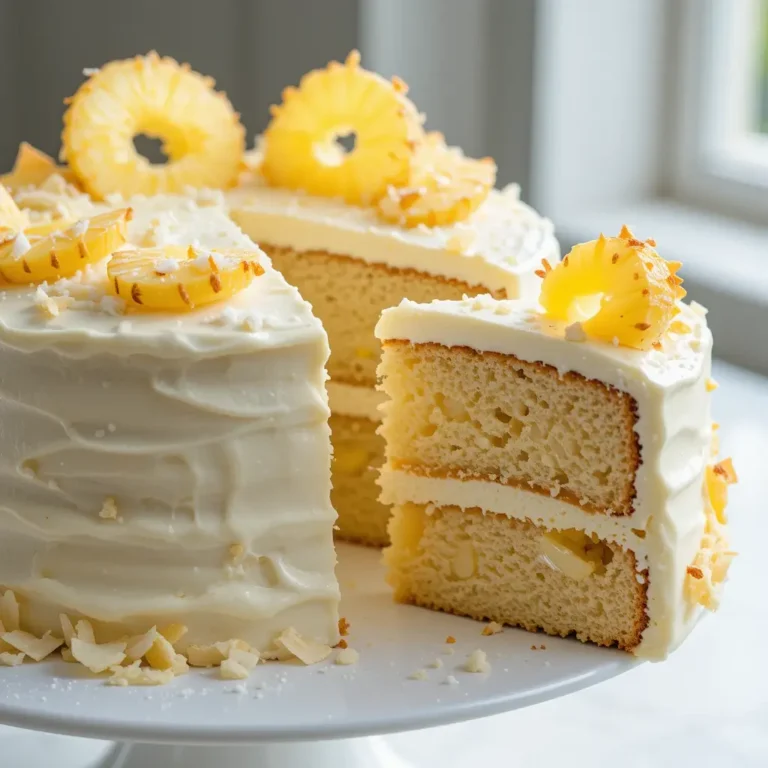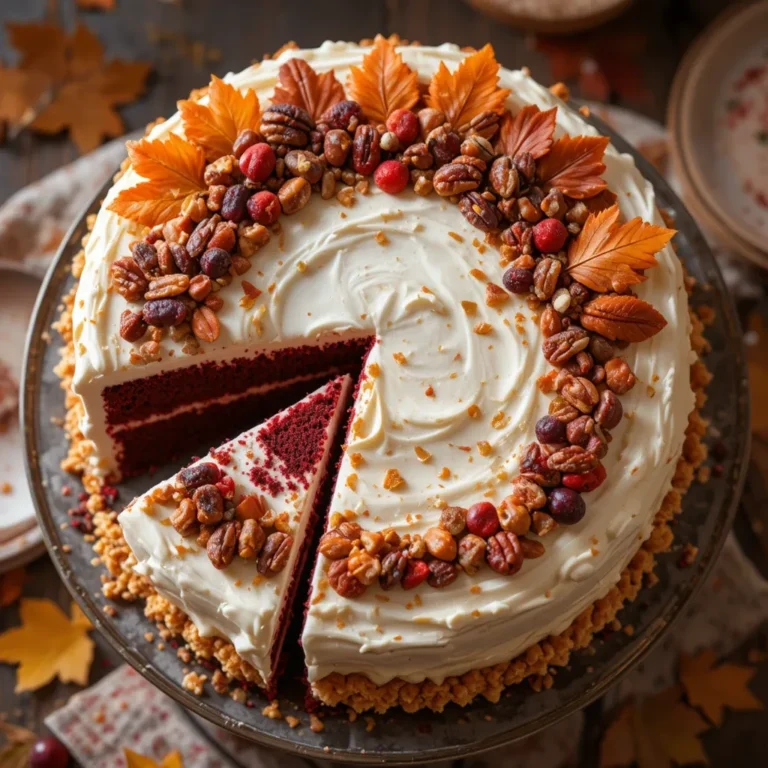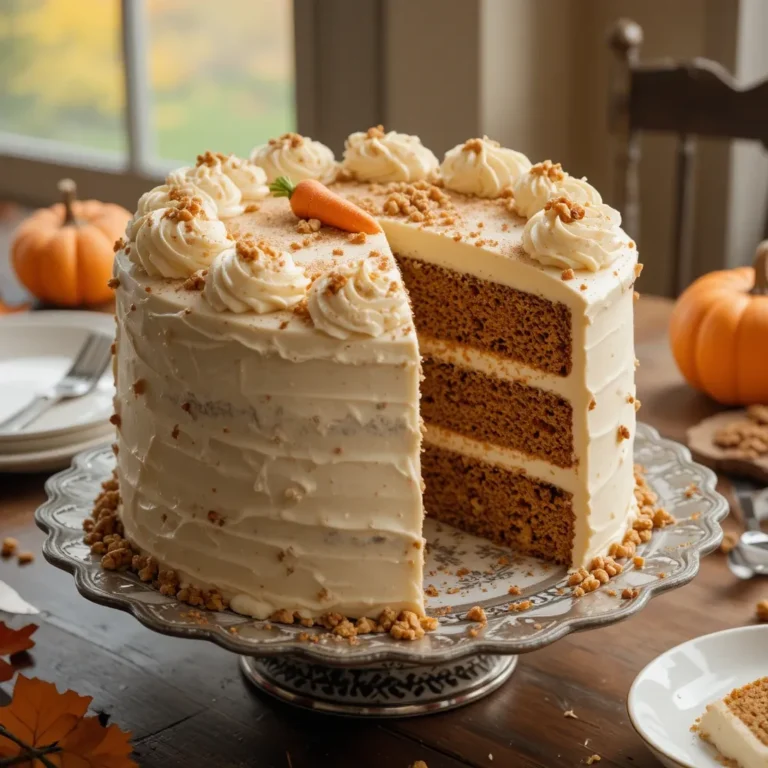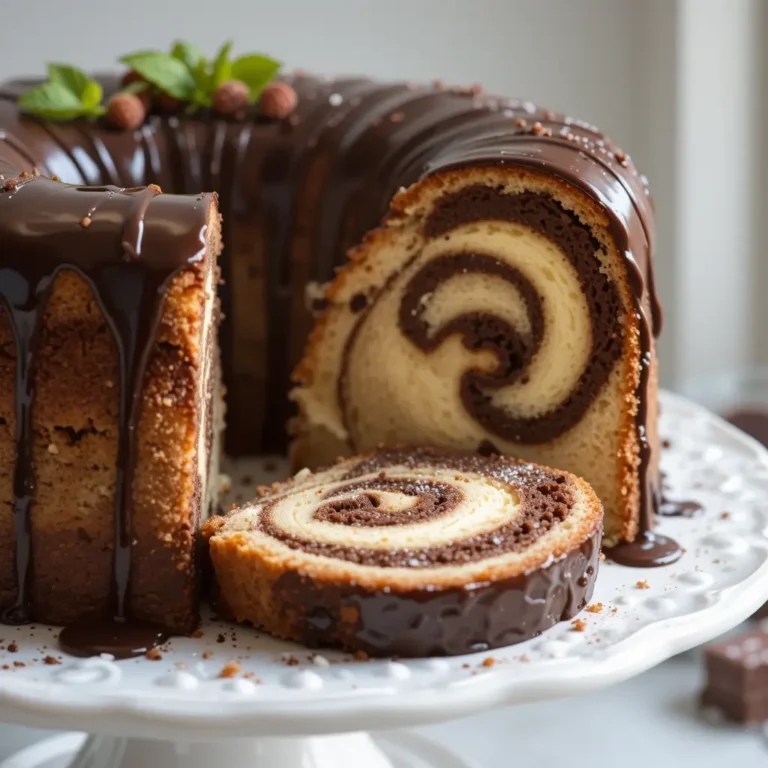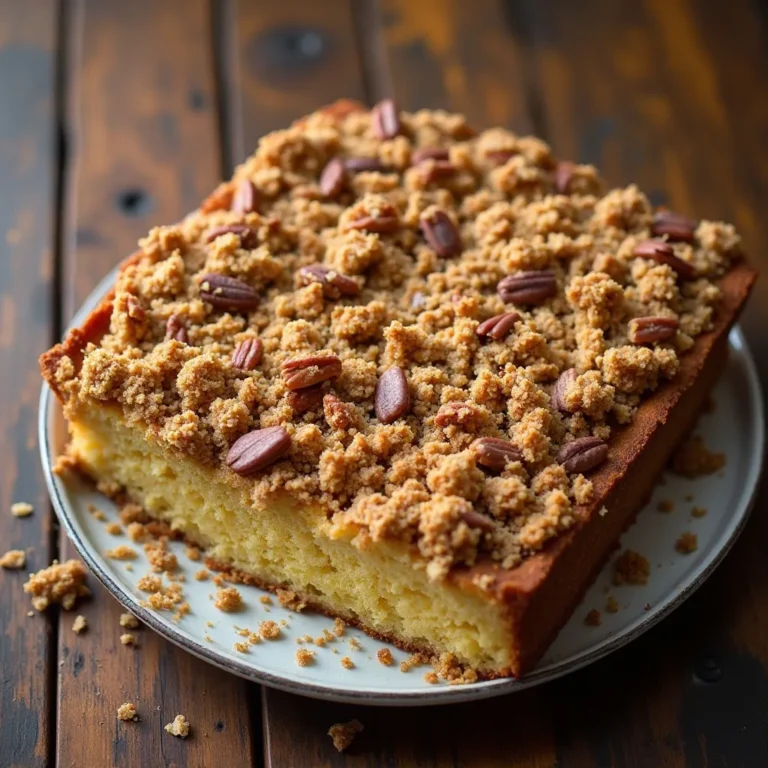Turkey Cheesecake – The Most Unique Holiday Appetizer Ever!
Discover how to make turkey cheesecake for Thanksgiving, savory holiday dessert that combines rich flavors and festive presentation for your table.
If you’re tired of the same old appetizers and want something that’ll make your guests do a double-take, this turkey cheesecake is your answer! Rich, creamy, and packed with savory flavors, this isn’t your typical dessert cheesecake.
I stumbled upon this recipe years ago at a Thanksgiving potluck, and honestly, I thought someone was joking when they said “turkey cheesecake.” One bite changed everything!
This savory masterpiece combines cream cheese, tender turkey, and aromatic herbs into an elegant spread that’s surprisingly simple to make. Much like my popular spinach artichoke dip, this turkey cheesecake disappears within minutes at every gathering, but it feels so much fancier and more sophisticated.
What is Turkey Cheesecake?
Now, I know what you’re thinking—turkey and cheesecake in the same sentence? Has she lost her mind? Trust me, I had the same reaction! This isn’t a sweet dessert but rather a savory appetizer that’s structured like a cheesecake. Think of it as a sophisticated pâté meets cream cheese spread, baked to perfection in a springform pan.
The name throws everyone off at first, which honestly makes it even more fun to serve. After all, they say the way to a man’s heart is through his stomach, and nothing intrigues people more than a dish that challenges their expectations! Give this a try at your next gathering, and watch it become the talk of the party.
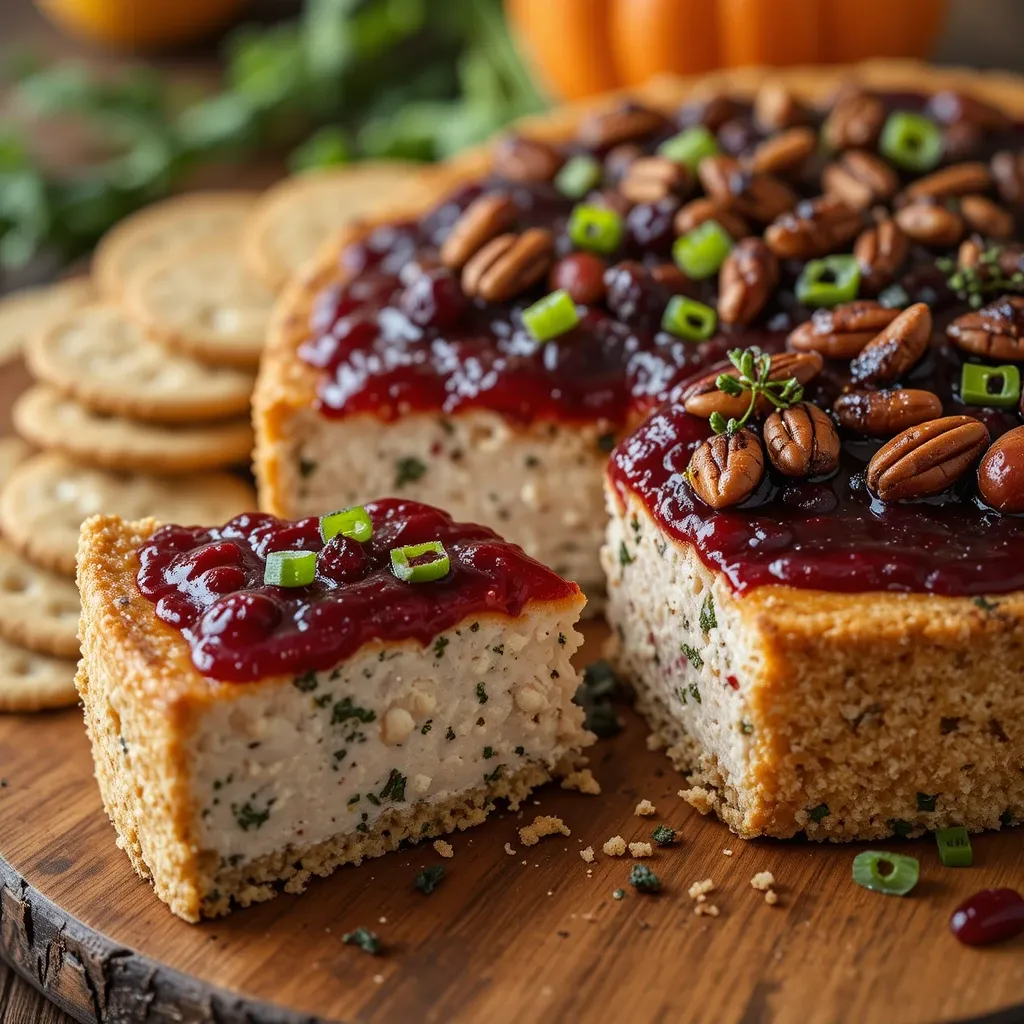
Why You’ll Love This Turkey Cheesecake
The star of this dish is the incredible texture—silky smooth cream cheese blended with seasoned ground turkey creates a spread that’s luxurious without being heavy. Each slice holds its shape beautifully, making it perfect for entertaining. You’ll love how impressive it looks on your appetizer table, especially when garnished with fresh herbs and cranberry sauce.
Making this at home saves you a fortune compared to buying gourmet appetizers from specialty stores. A single batch costs around $12-15 to make but serves 12-16 people easily. Compare that to pre-made artisan spreads that cost $8-10 for a tiny container! Plus, you control the ingredients, which means better quality and flavor.
The toppings are where you can really get creative. I love finishing mine with a layer of whole berry cranberry sauce, toasted pecans, and fresh thyme. The sweet-tart cranberries cut through the richness perfectly, while the pecans add a delightful crunch.
If you enjoyed my bacon-wrapped dates recipe, you’ll appreciate how this turkey cheesecake balances sweet and savory elements. The versatility means you can customize it for any occasion—add caramelized onions for a French-inspired version, or top with sun-dried tomatoes and basil for an Italian twist. Roll up your sleeves and give this recipe a try; your guests will be asking for the recipe all night!
How to Make Turkey Cheesecake
Quick Overview
This turkey cheesecake comes together easier than you’d think. The creamy, herb-infused filling bakes into a perfectly sliceable appetizer that tastes like you spent hours in the kitchen. The combination of seasoned turkey and tangy cream cheese creates an unforgettable flavor profile that’s both comforting and elegant.
Prep Time: 20 minutes Cook Time: 45 minutes
Cooling Time: 2 hours Total Time: 3 hours 5 minutes Servings: 12-16
Key Ingredients for Turkey Cheesecake
For the Crust:
- 1½ cups crushed buttery crackers (like Ritz)
- 4 tablespoons melted butter
- ¼ cup grated Parmesan cheese
- ½ teaspoon garlic powder
For the Filling:
- 16 oz cream cheese, softened (2 packages)
- 1 cup cooked ground turkey (about ¾ lb raw)
- ½ cup sour cream
- 3 large eggs
- 1 cup shredded sharp cheddar cheese
- ¼ cup finely chopped green onions
- 2 cloves garlic, minced
- 1 teaspoon dried thyme
- 1 teaspoon dried sage
- ½ teaspoon black pepper
- ½ teaspoon salt
- ¼ teaspoon cayenne pepper (optional)
For Topping:
- ½ cup whole berry cranberry sauce
- ¼ cup toasted pecans, chopped
- Fresh thyme sprigs
- Additional green onions for garnish
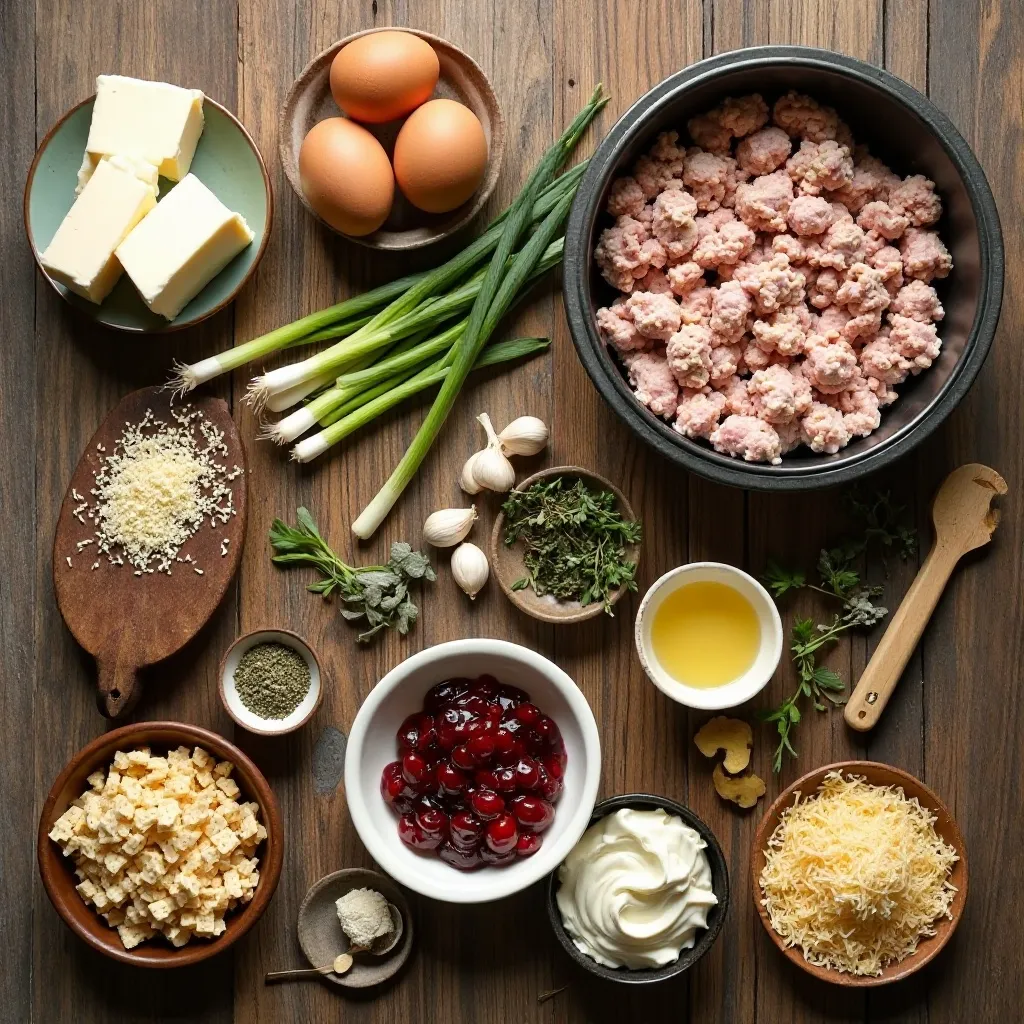
Step-by-Step Instructions
Step 1: Prepare Your Pan and Oven
Preheat your oven to 325°F. Take a 9-inch springform pan and wrap the outside bottom with aluminum foil to prevent any leaks. Grease the inside of the pan thoroughly with butter or cooking spray, making sure to get the sides well coated. This extra step ensures your cheesecake releases perfectly when serving.
Step 2: Make the Savory Crust
In a medium bowl, combine the crushed crackers, melted butter, Parmesan cheese, and garlic powder. Mix everything together with a fork until the mixture resembles wet sand and holds together when pressed. Pour this mixture into your prepared springform pan and press it firmly into the bottom using the back of a measuring cup or your fingers. Make sure the crust is even and compact. Bake the crust alone for 8 minutes, then remove and let it cool while you prepare the filling.
Step 3: Cook the Turkey
If you haven’t already cooked your turkey, heat a skillet over medium heat with a drizzle of oil. Add the ground turkey and cook for 6-8 minutes, breaking it apart with a wooden spoon until it’s fully cooked and no pink remains. Season lightly with salt and pepper while cooking. Drain any excess fat and let the turkey cool for 5 minutes. Once cooled, chop it finely or pulse it a few times in a food processor for a smoother texture.
Step 4: Prepare the Cream Cheese Base
In a large mixing bowl, beat the softened cream cheese with an electric mixer on medium speed for 2-3 minutes until it’s completely smooth and fluffy with no lumps. This step is crucial—lumpy cream cheese means a lumpy cheesecake! Add the sour cream and beat for another minute until well combined. The mixture should look silky and smooth.
Step 5: Combine the Filling Ingredients
Add the eggs one at a time to the cream cheese mixture, beating on low speed after each addition just until incorporated. Don’t overmix once the eggs are added, as this can cause cracking. Fold in the cooked turkey, shredded cheddar cheese, green onions, minced garlic, thyme, sage, black pepper, salt, and cayenne pepper if using. Mix gently with a spatula until everything is evenly distributed throughout the filling.
Step 6: Bake the Cheesecake
Pour the filling over the pre-baked crust, smoothing the top with a spatula. Tap the pan gently on the counter a few times to release any air bubbles. Place the springform pan in a larger roasting pan and carefully pour hot water into the roasting pan until it comes about halfway up the sides of the springform pan. This water bath helps the cheesecake bake evenly and prevents cracking. Bake for 45-50 minutes, until the edges are set but the center still has a slight jiggle when you gently shake the pan.
Step 7: Cool Properly
Turn off the oven and crack the door open slightly. Let the cheesecake cool in the oven for 30 minutes—this gradual temperature change prevents cracking. After 30 minutes, remove the cheesecake from the water bath and place it on a wire rack. Run a thin knife around the edges to loosen it from the pan, but don’t remove the springform ring yet. Let it cool to room temperature for about an hour, then refrigerate for at least 2 hours or overnight before serving.
Step 8: Add Toppings and Serve
Once completely chilled, carefully remove the springform pan ring. Spread the cranberry sauce over the top of the cheesecake, leaving a small border around the edge if desired. Sprinkle with toasted pecans and garnish with fresh thyme sprigs and sliced green onions. Slice with a sharp knife, wiping the blade clean between cuts for the prettiest slices. Serve with crackers, toasted baguette slices, or fresh vegetables.
What to Serve Turkey Cheesecake With
This turkey cheesecake pairs beautifully with an assortment of crackers—I love using water crackers, rosemary crackers, and seeded flatbread for variety. Toasted baguette slices or crostini are also excellent choices and add a nice crunch.
For a complete appetizer spread, serve alongside fresh vegetables like cucumber slices, cherry tomatoes, and bell pepper strips. The crisp, fresh vegetables provide a nice contrast to the rich, creamy cheesecake. A bowl of mixed olives and some cornichons add a nice briny element to your spread.
Drink-wise, this pairs wonderfully with a crisp white wine like Sauvignon Blanc or Pinot Grigio. If you prefer red, go for a light-bodied Pinot Noir. For non-alcoholic options, sparkling apple cider or a cranberry spritzer complements the flavors perfectly. A cheese board with complementary cheeses like aged cheddar, Gruyere, and a soft brie rounds out your appetizer table nicely.
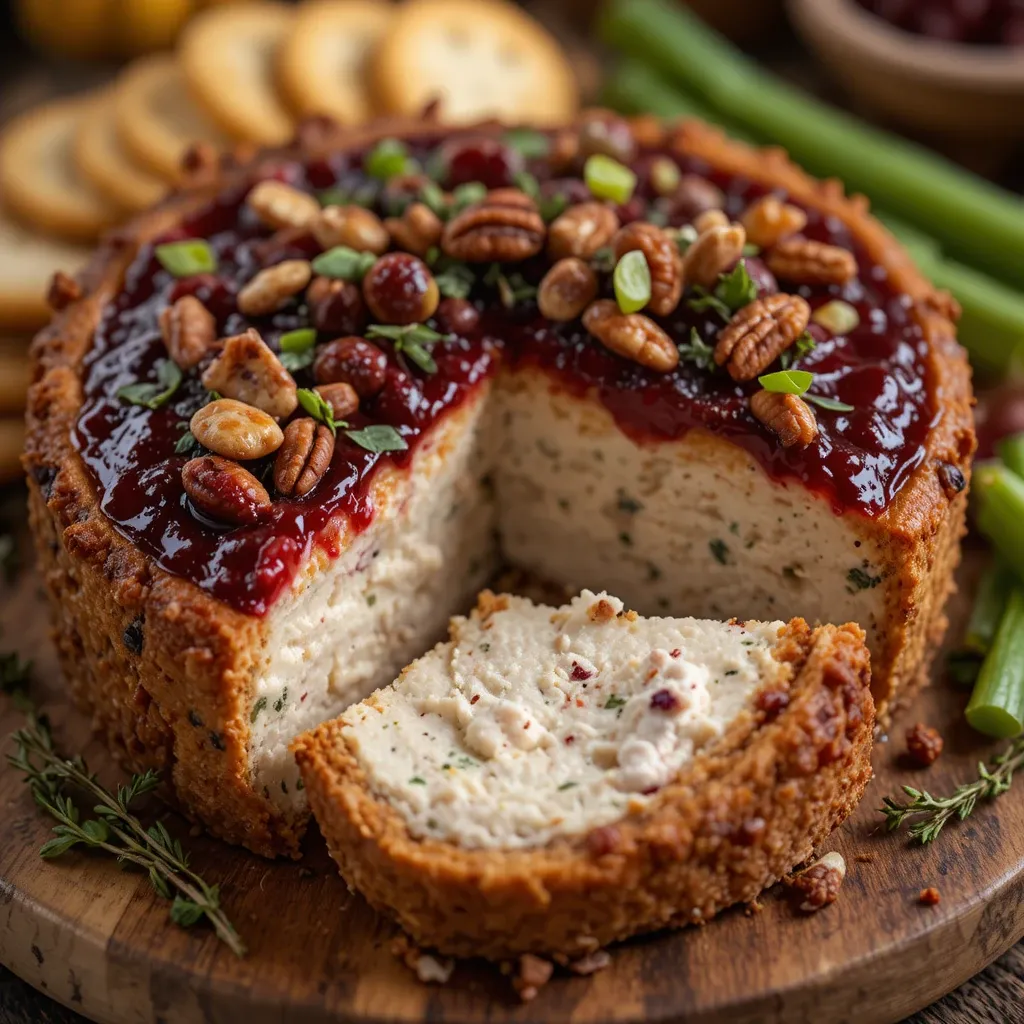
Top Tips for Perfecting Turkey Cheesecake
Use Room Temperature Ingredients: This is the golden rule for any cheesecake. Take your cream cheese, sour cream, and eggs out of the refrigerator at least an hour before you start. Room temperature ingredients blend together smoothly without overmixing, which means a creamier texture and fewer cracks. If you forgot, place the wrapped cream cheese in a bowl of warm water for 10 minutes.
Don’t Overmix After Adding Eggs: Once those eggs go in, mix on low speed and only until just combined. Overmixing incorporates too much air, which expands during baking and then collapses, causing cracks. Use a gentle hand and stop as soon as you don’t see any streaks of egg.
The Water Bath is Non-Negotiable: I know it seems fussy, but the water bath (bain-marie) is essential for even baking. It provides gentle, humid heat that prevents the top from drying out and cracking. Make sure your foil wrap is secure so no water seeps in. If you’re nervous about leaks, double-wrap the pan.
Season Your Turkey Well: Since the turkey is a main flavor component, don’t be shy with seasonings when cooking it. I sometimes add a splash of Worcestershire sauce or a pinch of smoked paprika to the turkey while it cooks for extra depth of flavor. Let it cool completely before adding to prevent the cream cheese from getting too warm.
Cool Gradually: The biggest mistake people make is rushing the cooling process. Temperature shock causes cracks. Leave it in the turned-off oven with the door cracked, then cool at room temperature, then refrigerate. Patience pays off with a perfect, crack-free surface.
Customize Your Toppings: While cranberry sauce is traditional, feel free to experiment. Caramelized onion jam, fig preserves, or even a savory tomato chutney work beautifully. Just make sure whatever you use isn’t too wet, or it might make the top soggy.
Make It Ahead: This is actually better when made a day in advance. The flavors meld together, and it’s easier to slice when fully chilled. You can make it up to two days ahead, just wait to add the toppings until a few hours before serving.
Storing and Reheating Tips
Store leftover turkey cheesecake tightly covered in the refrigerator for up to 5 days. I like to press plastic wrap directly onto the surface to prevent it from drying out, then cover the entire pan with foil. The flavors actually deepen after a day or two in the fridge, so don’t worry if you have leftovers—they might taste even better!
For longer storage, this cheesecake freezes beautifully for up to 2 months. Slice it into individual portions and wrap each piece tightly in plastic wrap, then place in a freezer-safe container or bag. This way, you can thaw just what you need. To thaw, transfer slices to the refrigerator overnight. Never thaw at room temperature, as this can affect the texture.
While this is typically served cold or at room temperature, you can warm individual slices if desired. Place a slice on a microwave-safe plate and heat for 15-20 seconds on 50% power, just until it loses its chill. Alternatively, let it sit at room temperature for 30 minutes before serving—the flavors are more pronounced when it’s not ice-cold. Don’t reheat the entire cheesecake, as this can cause it to become grainy or separate.
Common Baking Mistakes to Avoid
Mistake #1: Using Cold Cream Cheese: Nothing ruins a cheesecake faster than lumpy filling. Those lumps won’t smooth out during baking, and you’ll end up with an uneven texture. Always, always use room temperature cream cheese. Beat it well before adding other ingredients.
Mistake #2: Opening the Oven Door Too Often: Every time you open that door, the temperature drops dramatically, which can cause your cheesecake to sink or crack. Trust the process and resist peeking until the minimum baking time has passed. Use your oven light instead.
Mistake #3: Overbaking: A perfectly baked cheesecake should still jiggle slightly in the center—about a 2-inch circle in the middle. It will continue cooking and firm up as it cools. If it’s completely set when you take it out, it’s overbaked and will likely be dry. Remember, the edges should be set, but the center should wobble like gelatin.
Mistake #4: Skipping the Foil Wrap: Even if your springform pan seems tight, water can seep in during the water bath. That soggy bottom crust is disappointing and avoidable. Wrap the bottom and sides thoroughly with heavy-duty aluminum foil before placing it in the water bath.
Mistake #5: Using Too-Wet Toppings: If your cranberry sauce is very loose and liquidy, it can make the top of your cheesecake soggy. If needed, strain excess liquid or cook it down slightly to thicken it before spreading on top. Apply toppings only a few hours before serving for the best texture.
Mistake #6: Not Greasing the Pan Well Enough: Even though you’ll remove the springform sides, you still need to grease that pan thoroughly. The cheesecake can stick to the sides as it bakes, and when it cools and contracts, this tension can cause cracks. A generous coating of butter or cooking spray prevents this.
Mistake #7: Cutting While Warm: I know it’s tempting, but cutting into a warm cheesecake results in messy, sloppy slices. The filling needs to be completely chilled to set properly. Plan ahead and give yourself at least 2 hours of refrigeration time, preferably overnight.
Frequently Asked Questions
Can I use leftover Thanksgiving turkey instead of ground turkey?
Absolutely! Leftover turkey works wonderfully and adds great flavor. Chop it very finely or pulse it in a food processor until it’s about the texture of ground meat. You’ll need about 1 cup of finely chopped cooked turkey. If your leftover turkey is already seasoned, you might want to reduce the salt slightly in the recipe.
Why did my turkey cheesecake crack?
Cracks usually happen due to temperature shock or overbaking. Make sure you’re using a water bath for gentle, even heat. Don’t overbake—the center should still jiggle slightly when done. Most importantly, cool it gradually by leaving it in the turned-off oven with the door cracked, then at room temperature, before refrigerating. If it does crack, don’t worry! The topping covers it perfectly.
Can I make this recipe without a springform pan?
While a springform pan makes serving much easier, you can use a regular 9-inch pie dish or cake pan. Grease it very well and line the bottom with parchment paper. You won’t be able to remove the sides, so you’ll need to slice and serve directly from the dish. It won’t look quite as elegant, but it will taste just as delicious.
Is turkey cheesecake served hot or cold?
This is best served chilled or at room temperature. I like to remove it from the refrigerator about 20-30 minutes before serving so it’s not ice-cold, which allows the flavors to shine through. You can warm individual slices slightly if you prefer, but it’s traditionally served cold as an appetizer spread.
Can I substitute the turkey with chicken?
Yes! Ground chicken or finely chopped cooked chicken works perfectly. You can also use ground pork or even a combination of meats. For a vegetarian version, try using finely chopped mushrooms sautéed until all their liquid has evaporated—they provide a wonderful meaty texture and umami flavor.
How far in advance can I make turkey cheesecake?
This is perfect for make-ahead entertaining. You can bake the cheesecake up to 2 days in advance and store it covered in the refrigerator. Wait to add the cranberry topping and garnishes until 2-4 hours before serving so they look fresh. The flavors actually improve after a day in the fridge.
My cheesecake is too soft and won’t slice cleanly. What went wrong?
This usually means it’s underbaked or hasn’t chilled long enough. Make sure you’re baking until the edges are completely set and only the center 2-inch circle jiggles. Then refrigerate for at least 2 hours, but overnight is better. For the cleanest slices, use a sharp knife and wipe it clean with a hot, damp towel between each cut.
Can I freeze turkey cheesecake?
Yes! This freezes beautifully for up to 2 months. I recommend freezing it without the cranberry topping—add that after thawing. Wrap tightly in plastic wrap and aluminum foil, or freeze individual slices for easier thawing. Thaw overnight in the refrigerator before serving.
Nutrition Information (Per Serving, based on 14 servings)
| Nutrient | Amount |
|---|---|
| Calories | 285 |
| Total Fat | 24g |
| Saturated Fat | 13g |
| Cholesterol | 115mg |
| Sodium | 340mg |
| Total Carbohydrates | 8g |
| Dietary Fiber | 0.5g |
| Sugars | 3g |
| Protein | 11g |
| Vitamin A | 15% DV |
| Calcium | 12% DV |
| Iron | 6% DV |
This turkey cheesecake has become my secret weapon for holiday gatherings. The first time I made it, I was skeptical about the whole concept, but now I can’t imagine my Thanksgiving table without it. There’s something magical about watching guests’ faces go from confused to amazed as they take their first bite.
The creamy, savory filling paired with sweet-tart cranberries creates a flavor combination that’s both unexpected and totally addictive. Whether you’re hosting Thanksgiving, a Christmas party, or just want to impress at your next potluck, this turkey cheesecake delivers wow-factor without the stress. Give it a try—I promise it’ll become your new favorite conversation starter!

